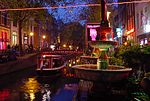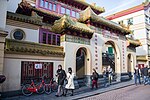De Wallen

De Wallen (Dutch pronunciation: [də ˈʋɑlə(n)]) or De Walletjes (Dutch pronunciation: [də ˈʋɑləcəs]) was the largest and best known red-light district in Amsterdam prior to being temporarily shut down in 2020 due to the COVID-19 pandemic. It consists of a network of alleys containing approximately three hundred one-room cabins rented by prostitutes who offer their sexual services from behind a window or glass door, typically illuminated with red lights and blacklight. Window prostitution is the most visible and typical kind of red-light district sex work in Amsterdam. De Wallen, together with the prostitution areas Singelgebied and Ruysdaelkade, form the Rosse Buurt (red-light areas) of Amsterdam. Of these De Wallen is the oldest and largest area. It is one of the city's major tourist attractions and the government of Amsterdam is examining ways to limit tourist numbers.The area also has a number of sex shops, sex theatres, peep shows, a sex museum, a cannabis museum, and a number of coffee shops that sell cannabis.
Excerpt from the Wikipedia article De Wallen (License: CC BY-SA 3.0, Authors, Images).De Wallen
Oudezijds Achterburgwal, Amsterdam Centrum
Geographical coordinates (GPS) Address External links Nearby Places Show on map
Geographical coordinates (GPS)
| Latitude | Longitude |
|---|---|
| N 52.373416666667 ° | E 4.8980555555556 ° |
Address
de Wallen
Oudezijds Achterburgwal
1012 DM Amsterdam, Centrum
North Holland, Netherlands
Open on Google Maps










